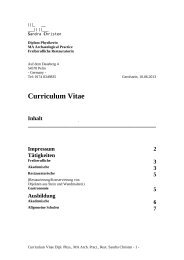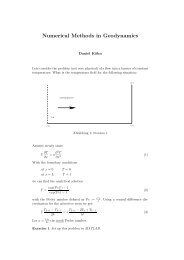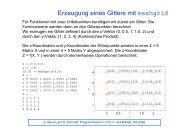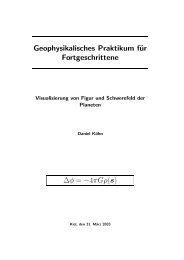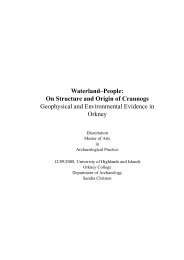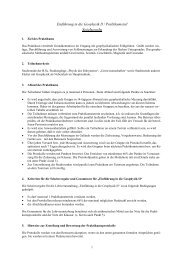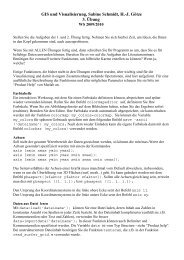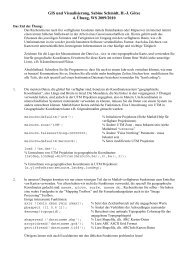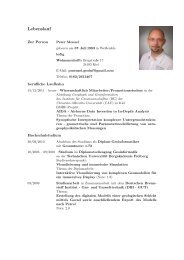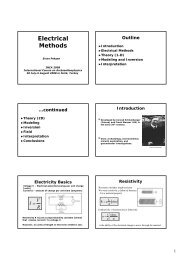Full Waveform Tomography - Part 1 Theory
Full Waveform Tomography - Part 1 Theory
Full Waveform Tomography - Part 1 Theory
Create successful ePaper yourself
Turn your PDF publications into a flip-book with our unique Google optimized e-Paper software.
<strong>Full</strong> <strong>Waveform</strong> <strong>Tomography</strong><br />
- <strong>Part</strong> 1 <strong>Theory</strong><br />
Daniel Köhn, Denise De Nil, André Kurzmann<br />
December 8, 2011
<strong>Full</strong> <strong>Waveform</strong> <strong>Tomography</strong><br />
- <strong>Part</strong> 1 <strong>Theory</strong><br />
1 References<br />
2 Motivation<br />
3 Nonlinear optimization using the gradient method<br />
4 Calculate gradients for elastic full waveform tomography
References<br />
Aki, K. and Richards, P. (1980).<br />
Quantitative seismology.<br />
W.H. Freeman and Company.<br />
Brossier, R. (2009).<br />
Imagerie sismique á deux dimensions des milieux visco-élastiques par inversion<br />
des formes d’ondes : développements méthodologiques et applications.<br />
PhD thesis, Universite de Nice - Sophia Antipolis.<br />
http://users.isterre.fr/brossier/Documents/PhD/brossier_these.pdf.<br />
Köhn, D. (2011).<br />
Time Domain 2D Elastic <strong>Full</strong> <strong>Waveform</strong> <strong>Tomography</strong>.<br />
PhD thesis, Kiel University.<br />
http://nbn-resolving.de/urn:nbn:de:gbv:8-diss-67866.<br />
Nocedal, J. and Wright, S. (1999).<br />
Numerical Optimization.<br />
Springer, New York.<br />
Tarantola, A. (2005).<br />
Inverse Problem <strong>Theory</strong>.<br />
SIAM.
Motivation<br />
Resolution: Traveltime <strong>Tomography</strong><br />
P−wave velocity (Traveltime <strong>Tomography</strong>)<br />
V p<br />
[m/s]<br />
y [km]<br />
0.5<br />
1<br />
1.5<br />
2<br />
2.5<br />
3<br />
4500<br />
4000<br />
3500<br />
1 2 3 4 5 6 7 8 9 10<br />
P−wave velocity (true model)<br />
3000<br />
y [km]<br />
0.5<br />
1<br />
1.5<br />
2<br />
2.5<br />
3<br />
1 2 3 4 5 6 7 8 9 10<br />
x [km]<br />
2500<br />
2000<br />
1500
Motivation<br />
Resolution: <strong>Waveform</strong> <strong>Tomography</strong><br />
P−wave velocity (<strong>Waveform</strong> <strong>Tomography</strong>)<br />
V p<br />
[m/s]<br />
y [km]<br />
0.5<br />
1<br />
1.5<br />
2<br />
2.5<br />
3<br />
4500<br />
4000<br />
3500<br />
1 2 3 4 5 6 7 8 9 10<br />
P−wave velocity (true model)<br />
3000<br />
y [km]<br />
0.5<br />
1<br />
1.5<br />
2<br />
2.5<br />
3<br />
1 2 3 4 5 6 7 8 9 10<br />
x [km]<br />
2500<br />
2000<br />
1500
Motivation: Estimate optimum model from data<br />
Seismic Section<br />
<strong>Waveform</strong> <strong>Tomography</strong><br />
← Time<br />
← Depth<br />
channel # →<br />
Distance →<br />
Problems<br />
1 What is an ”optimum” model ?<br />
2 How can this model be found ?<br />
3 Is this model unique or are other models existing, which could<br />
explain the data equally well ?
What is an ”optimum” model ?<br />
Definition: data residuals and misfit function<br />
u mod<br />
−<br />
u obs<br />
=<br />
δ u<br />
← time<br />
channel →<br />
channel →<br />
channel →<br />
Data residuals: δu = u mod −u obs<br />
The L2-norm (Residual Energy) of the data residuals: E = 1 2 δuT δu
How to find an optimum model ?<br />
Parameter space<br />
Residual Energy E<br />
250<br />
200<br />
m true<br />
50<br />
Density ρ →<br />
150<br />
100<br />
P−wave velocity Vp →<br />
Minimize residual energy: E = 1 2 δuT δu → Min
How to find an optimum model ?<br />
Define starting point in the parameter space<br />
Residual Energy E<br />
250<br />
200<br />
Density ρ →<br />
150<br />
100<br />
m 1<br />
m true<br />
50<br />
P−wave velocity Vp →<br />
Start search with an initial guess m 1 .
How to find an optimum model ?<br />
Iterative model update<br />
Residual Energy E<br />
250<br />
m true<br />
200<br />
Density ρ →<br />
m 1<br />
m 2<br />
δm 1<br />
50<br />
150<br />
100<br />
P−wave velocity Vp →<br />
Update the model iteratively: m 2 = m 1 +µ 1 δm 1 .<br />
δm 1 denotes the direction and µ 1 the steplength.
How to find an optimum model ?<br />
Iterative model update<br />
Residual Energy E<br />
250<br />
200<br />
m true<br />
50<br />
Density ρ →<br />
150<br />
100<br />
P−wave velocity Vp →<br />
Which direction δm 1 should be choosen ?
How to find an optimum model ?<br />
Find optimum search direction ...<br />
Taylor series expansion:<br />
( ) ∂E<br />
E(m 1 +δm 1 ) ≈ E(m 1 )+δm 1<br />
∂m<br />
Set derivative to zero:<br />
... which leads to:<br />
∂E(m 1 +δm 1 )<br />
∂δm 1<br />
=<br />
1<br />
+ 1 ( ∂ 2<br />
2 δm E<br />
1<br />
∂m<br />
)1<br />
2 δm T 1<br />
( ) ( ∂E ∂ 2 E<br />
+δm 1<br />
∂m<br />
1<br />
∂m<br />
)1<br />
2 = 0<br />
( )<br />
−1 ∂E<br />
δm 1 = −H 1<br />
∂m<br />
where (∂E/∂m) 1 denotes the gradient direction of the objective<br />
function and H 1 −1 the inverse Hessian matrix.<br />
1
How to find an optimum model ?<br />
Pure Gradient Method<br />
Residual Energy E<br />
250<br />
200<br />
Density ρ →<br />
150<br />
100<br />
50<br />
P−wave velocity Vp →<br />
Gradient method: m n+1 = m n −µ n P n<br />
(∂E<br />
∂m<br />
)<br />
n
Calculation of the gradient direction ∂E<br />
∂m<br />
Gradient<br />
To estimate the gradient direction ∂E/∂m the residual energy is<br />
rewritten as:<br />
E = 1 2 δuT δu = 1 ∑<br />
∫<br />
dt ∑<br />
δu 2 (x r ,x s ,t)<br />
2<br />
sources<br />
receiver<br />
After derivation with respect to a model parameter m we get<br />
∂E<br />
∂m = ∑ ∫<br />
dt ∑ ∂δu<br />
∂m δu<br />
sources<br />
= ∑<br />
sources<br />
= ∑<br />
sources<br />
∫<br />
∫<br />
receiver<br />
dt ∑<br />
receiver<br />
dt ∑<br />
receiver<br />
∂(u mod (m)−u obs )<br />
δu<br />
∂m<br />
∂u mod (m)<br />
∂m<br />
δu
Calculation of the gradient direction ∂E<br />
∂m<br />
Mapping model space → data ←space (forward problem)<br />
Data Space<br />
Model Space<br />
← time<br />
← depth<br />
x−coordinate →<br />
x−coordinate →
Calculation of the gradient direction ∂E<br />
∂m<br />
Mapping model space → data ←space (forward problem)<br />
Data Space<br />
Model Space<br />
← time<br />
δũ<br />
← depth<br />
δm<br />
x−coordinate →<br />
x−coordinate →<br />
δũ(x s ,x r ,t) = ∂u<br />
∂m δm
Calculation of the gradient direction ∂E<br />
∂m<br />
Mapping model space → data ←space (Forward Problem)<br />
Data Space<br />
Model Space<br />
← time<br />
δũ<br />
← depth<br />
δm<br />
x−coordinate →<br />
∫<br />
δũ(x s ,x r ,t) =<br />
V<br />
dV ∂u<br />
∂m δm<br />
x−coordinate →
Calculation of the gradient direction ∂E<br />
∂m<br />
Mapping data space → model →space (Inverse Problem)<br />
Data Space<br />
Model Space<br />
← time<br />
δũ ′<br />
← depth<br />
δm ′<br />
x−coordinate →<br />
δm ′ = ∑ ∫<br />
sources<br />
dt ∑<br />
receiver<br />
x−coordinate →<br />
[ ] ∂u ∗<br />
δũ ′<br />
∂m
Calculation of the gradient direction ∂E<br />
∂m<br />
Properties of linear operators<br />
By introducing the linear operator ˆL the integrals can be written<br />
as:<br />
∫<br />
δũ = ˆLδm := dV ∂u<br />
∂m δm.<br />
and<br />
δm ′ = ˆL ∗ δũ ′ := ∑<br />
sources<br />
∫<br />
V<br />
dt ∑<br />
receiver<br />
[ ] ∂u ∗<br />
δũ ′ .<br />
∂m<br />
Because the operator ˆL is linear, the kernel of ˆL and it’s adjoint<br />
counterpart ˆL ∗ are identical (see chapter 5.4.2 in [Tarantola, 2005])<br />
[ ] ∂u ∗ [ ] ∂u<br />
=<br />
∂m ∂m
Calculation of the gradient direction ∂E<br />
∂m<br />
δm ′ = ∂E<br />
∂m<br />
Therefore the mapping from the data to the model space is equal<br />
to the gradient of the residual energy:<br />
δm ′ = ∑ ∫<br />
dt ∑ [ ] ∗ ∂ui<br />
δũ ′<br />
sources<br />
= ∑<br />
sources<br />
= ∂E<br />
∂m<br />
∫<br />
∂m<br />
receiver<br />
dt ∑ [ ∂ui<br />
∂m<br />
receiver<br />
]<br />
δu<br />
if the perturbation of the data space δũ ′ is interpretated as data<br />
residuals δu.
Calculation of the gradient direction ∂E<br />
∂m<br />
General approach to estimate the gradient<br />
So the approach to estimate the gradient direction ∂E/∂m can be<br />
split into 3 parts<br />
1 Find a solution to the forward problem<br />
δu = ˆLδm.<br />
2 Identify the Frechét kernels ∂u/∂m<br />
3 Use the property, that a linear operator ˆL and it’s adjoint ˆL ∗<br />
have the same kernels and calculate the gradient direction by<br />
using:<br />
∂E<br />
∂m = δm′ = ˆL ∗ δu ′ .
Calculation of the gradient direction ∂E<br />
∂m<br />
Possible applications<br />
This approach is very general and can be applied to a wide range<br />
of physical problems<br />
Quantum Mechanics: Schrödingers Equation<br />
Hydrodynamics: Oceanography, Meteorology<br />
Electrodynamics: GPR<br />
Medical Diagnostics: Acoustic Wave Equation<br />
Magnetohydrodynamics: Astrophysics, Plasmaphysics<br />
General Relativity: Metric of the Space-Time
Calculation of the gradient direction ∂E<br />
∂m<br />
Elastic equations of motion for anisotropic media<br />
ρ ∂2 u i<br />
∂t 2 − ∂<br />
∂x j<br />
σ ij = f i ,<br />
σ ij −c ijkl ǫ kl = T ij ,<br />
ǫ ij = 1 ( ∂ui<br />
+ ∂u )<br />
j<br />
,<br />
2 ∂x j ∂x i<br />
+ initial and boundary conditions,<br />
where ρ denotes the density, u i the displacement, σ ij the stress<br />
tensor, ǫ ij the strain tensor, c ijkl the stiffness tensor, f i , T ij source<br />
terms for volume and surface forces, respectively.
Calculation of the gradient direction ∂E<br />
∂m<br />
First order perturbations<br />
In the next step every parameter and variable in the elastic wave<br />
equation is perturbated by a first order perturbation:<br />
u i → u i +δu i ,<br />
σ ij → σ ij +δσ ij<br />
ǫ ij → ǫ ij +δǫ ij<br />
ρ→ ρ+δρ<br />
c ijkl → c ijkl +δc ijkl
Calculation of the gradient direction ∂E<br />
∂m<br />
Pertubated elastic equations of motion<br />
ρ ∂2 δu i<br />
∂t 2 − ∂<br />
∂x j<br />
δσ ij = ∆f i<br />
δσ ij −c ijkl δǫ kl = ∆T ij<br />
δǫ ij = 1 ( ∂δui<br />
+ ∂δu )<br />
j<br />
2 ∂x j ∂x i<br />
+ perturbated initial and boundary conditions<br />
The new source terms are<br />
∆f i = −δρ ∂2 u i<br />
∂t 2 , ∆T ij= δc ijkl ǫ kl .
Calculation of the gradient direction ∂E<br />
∂m<br />
Definition: Green’s function<br />
If a unit impulse is applied as a source term at x = x ′ at time<br />
t = t ′ in the n-direction, then we denote the ith component of the<br />
displacement field at any point (x,t) as Green’s function<br />
G in (x,t;x ′ ,t ′ ) ([Aki and Richards, 1980]).<br />
ρ ∂2 G in<br />
∂t 2 − ∂σ ij<br />
∂x j<br />
= δ in δ(x−x ′ )δ(t−t ′ )<br />
σ ij = c ijkl ǫ kl .
Calculation of the gradient direction ∂E<br />
∂m<br />
Solution of the perturbated wave equation in terms of Green’s<br />
function<br />
The solution of the perturbated elastic equations of motion in<br />
terms of the elastic Green’s function G ij (x,t;x ′ ,t ′ ) can be written<br />
as:<br />
∫ ∫ T<br />
δu i (x,t)= dV dt ′ G ij (x,t;x ′ ,t ′ )∆f j (x ′ ,t ′ )<br />
∫<br />
−<br />
V<br />
V<br />
dV<br />
0<br />
∫ T<br />
0<br />
dt ′∂G ij<br />
∂x ′ (x,t;x ′ ,t ′ )∆T jk (x ′ ,t ′ ).<br />
k
Calculation of the gradient direction ∂E<br />
∂m<br />
Subsitute source terms of the perturbated equations of motion<br />
Substituting the force and traction source terms yields after some<br />
rearranging<br />
∫<br />
δu i (x,t)= −<br />
V<br />
∫<br />
− dV<br />
V<br />
dV<br />
∫ T<br />
0<br />
∫ T<br />
0<br />
dt ′ G ij (x,t;x ′ ,t ′ ) ∂2 u j<br />
∂t 2 (x′ ,t ′ )δρ<br />
dt ′∂G ij<br />
∂x ′ (x,t;x ′ ,t ′ )ǫ lm (x ′ ,t ′ )δc jklm<br />
k
Calculation of the gradient direction ∂E<br />
∂m<br />
Born approximation<br />
Introducing isotropy via<br />
leads to:<br />
∫<br />
δu i (x,t)= −<br />
∫<br />
−<br />
∫<br />
−<br />
V<br />
V<br />
[∫ T<br />
dV<br />
0<br />
[∫ T<br />
dV<br />
0<br />
c ijkl = δ ij δ kl δλ+(δ ik δ jl +δ il δ jk )δµ<br />
V<br />
[∫ T<br />
]<br />
dV dt ′ G ij (x,t;x ′ ,t ′ ) ∂2 u j<br />
0 ∂t 2 (x′ ,t ′ ) δρ<br />
dt ′∂G ij<br />
∂x ′ (x,t;x ′ ,t ′ )ǫ lm (x ′ ,t ′ )δ jk δ lm<br />
]δλ<br />
k<br />
dt ′∂G ij<br />
∂x ′ (x,t;x ′ ,t ′ )ǫ lm (x ′ ,t ′ )(δ jl δ lm +δ jm δ kl )<br />
k<br />
]<br />
δµ.<br />
This equation has the same form as the desired expression for the<br />
forward problem: ∫<br />
δu = dV ∂u<br />
∂m δm.<br />
V
Calculation of the gradient direction ∂E<br />
∂m<br />
Identify Frechét kernels<br />
Therefore the Frechét kernels<br />
parameters can be identified as:<br />
∫<br />
∂u T i<br />
∂ρ = −<br />
0<br />
∫<br />
∂u T i<br />
∂λ = −<br />
0<br />
∫<br />
∂u T i<br />
∂µ = −<br />
0<br />
∂u i<br />
∂m(x)<br />
dt ′ G ij (x,t;x ′ ,t ′ ) ∂2 u j<br />
∂t 2 (x′ ,t ′ )<br />
for the individual material<br />
dt ′∂G ij<br />
∂x ′ (x,t;x ′ ,t ′ )ǫ lm (x ′ ,t ′ )δ jk δ lm<br />
k<br />
dt ′∂G ij<br />
∂x ′ (x,t;x ′ ,t ′ )ǫ lm (x ′ ,t ′ )(δ jl δ lm +δ jm δ kl )<br />
k
Calculation of the gradient direction ∂E<br />
∂m<br />
Definition of the adjoint operator<br />
By definition the adjoint of the operator can be written as<br />
δm ′ (x) = ∑<br />
∫ T<br />
sources 0<br />
N∑<br />
rec<br />
[ ] ∗ ∂ui<br />
dt δu ′<br />
∂m<br />
i(x α ,t ′ ),<br />
α=1
Calculation of the gradient direction ∂E<br />
∂m<br />
Calculate adjoint operators<br />
Because a linear operator and its transpose have the same kernels<br />
∂u i /∂m, the only difference arise in the variables of<br />
sum/integration, which are complementary. Inserting the integral<br />
kernels yields<br />
δρ ′ = − ∑ ∫ T N∑<br />
rec ∫ T<br />
dt<br />
sources 0 α=1 0<br />
δλ ′ = − ∑ ∫ T N∑<br />
rec ∫ T<br />
dt<br />
sources 0 α=1 0<br />
δµ ′ = − ∑ ∫ T N∑<br />
rec ∫ T<br />
dt<br />
sources 0 α=1 0<br />
dt ′ G ij (x α,t ′ ;x,t) ∂2 u j<br />
∂t 2 (x,t)δu′ i (xα,t′ ),<br />
dt ′∂G ij<br />
∂x k<br />
(x α,t ′ ;x,t)ǫ lm (x,t)δ jk δ lm δu ′ i (xα,t′ ),<br />
dt ′∂G ij<br />
∂x k<br />
(x α,t ′ ;x,t)ǫ lm (x,t)(δ jl δ lm +δ jm δ kl )δu ′ i (xα,t′ ).
Calculation of the gradient direction ∂E<br />
∂m<br />
Some rearrangements ...<br />
The terms only depending on time t and the positions x can be<br />
moved infront of the sum over the receivers<br />
δρ ′ = − ∑ ∫ T<br />
dt ∂2 N<br />
u rec<br />
j<br />
sources 0 ∂t 2 (x,t) ∑<br />
∫ T<br />
dt ′ G ij (x α,t ′ ;x,t)δu ′ i (xα,t′ ),<br />
α=1 0<br />
δλ ′ = − ∑ ∫ T<br />
N∑<br />
rec ∫ T<br />
dtǫ lm (x,t)δ jk δ lm dt ′∂G ij<br />
(x α,t ′ ;x,t)δu ′ i<br />
sources 0<br />
α=1 0 ∂x (xα,t′ ),<br />
k<br />
δµ ′ = − ∑ ∫ T<br />
N∑<br />
rec ∫ T<br />
dtǫ lm (x,t)(δ jl δ lm +δ jm δ kl ) dt ′∂G ij<br />
(x α,t ′ ;x,t)δu ′ i<br />
sources 0<br />
α=1 0 ∂x (xα,t′ ).<br />
k
Calculation of the gradient direction ∂E<br />
∂m<br />
Introducing the wavefield Ψ j<br />
Defining the wavefield<br />
yields<br />
N∑<br />
rec<br />
Ψ j (x,t)=<br />
δρ ′ = − ∑<br />
δλ ′ = − ∑<br />
δµ ′ = − ∑<br />
α=1<br />
∫ T<br />
0<br />
∫ T<br />
sources 0<br />
∫ T<br />
sources 0<br />
∫ T<br />
sources<br />
0<br />
dt ′ G ij (x α ,t ′ ;x,t)δu ′ i(x α ,t ′ ),<br />
dt ∂2 u j<br />
∂t 2 (x,t)Ψ j,<br />
dtǫ lm (x,t)δ jk δ lm<br />
∂Ψ j<br />
∂x k<br />
,<br />
dtǫ lm (x,t)(δ jl δ lm +δ jm δ kl ) ∂Ψ j<br />
∂x k<br />
.
Calculation of the gradient direction ∂E<br />
∂m<br />
Calculate implicit sums ...<br />
Writing out the implicit sums in the gradients of the Lamé<br />
parameters δλ ′ and δµ ′<br />
δλ ′ = − ∑<br />
δµ ′ = − ∑<br />
∫ T<br />
sources 0<br />
∫ T<br />
sources<br />
0<br />
dt ∑ l<br />
dt ∑ l<br />
∑∑∑<br />
∂Ψ j<br />
ǫ lm (x,t)δ jk δ lm ,<br />
∂x k<br />
k<br />
k<br />
j<br />
j<br />
m<br />
∑∑∑<br />
ǫ lm (x,t)(δ jl δ lm +δ jm δ kl ) ∂Ψ j<br />
.<br />
∂x k<br />
m
Calculation of the gradient direction ∂E<br />
∂m<br />
... leads to<br />
Neglecting all wavefield components and derivatives in z-direction<br />
leads to<br />
δλ ′ = − ∑<br />
δµ ′ = − ∑<br />
(<br />
+2<br />
∫ T<br />
sources 0<br />
∫ T<br />
sources<br />
0<br />
ǫ xx<br />
∂Ψ x<br />
∂x +ǫ yy<br />
( )( ∂Ψx<br />
dt ǫ xx +ǫ yy<br />
[( )( ∂Ψx<br />
dt ǫ xy +ǫ yx<br />
)<br />
∂Ψ y<br />
.<br />
∂y<br />
)<br />
,<br />
∂x + ∂Ψ y<br />
∂y<br />
∂y + ∂Ψ )]<br />
y<br />
∂x
Calculation of the gradient direction ∂E<br />
∂m<br />
Introducing the strain tensor<br />
Using the definition of the strain tensor ǫ ij we get<br />
δλ ′ = − ∑<br />
δµ ′ = − ∑<br />
∫ T<br />
sources 0<br />
∫ T<br />
sources<br />
( ∂ux<br />
+2<br />
∂x<br />
0<br />
( ∂ux<br />
dt<br />
[( ∂ux<br />
dt<br />
∂Ψ x<br />
∂x + ∂u y<br />
∂y<br />
∂x + ∂u y<br />
∂y<br />
∂y + ∂u y<br />
∂x<br />
)<br />
.<br />
∂Ψ y<br />
∂y<br />
)( ∂Ψx<br />
∂x + ∂Ψ y<br />
∂y<br />
)( ∂Ψx<br />
∂y + ∂Ψ y<br />
∂x<br />
)<br />
,<br />
)]
Calculation of the gradient direction ∂E<br />
∂m<br />
Final gradients<br />
Finally the gradients for the Lamé parameters λ, µ and the density<br />
ρ can be written as<br />
δλ ′ = − ∑ ∫ ( ∂ux<br />
dt<br />
∂x + ∂u )(<br />
y ∂Ψx<br />
∂y ∂x + ∂Ψ )<br />
y<br />
∂y<br />
sources<br />
δµ ′ = − ∑ ∫ ( ∂ux<br />
dt<br />
∂y + ∂u )(<br />
y ∂Ψx<br />
∂x ∂y + ∂Ψ )<br />
y<br />
∂x<br />
sources<br />
( ∂ux ∂Ψ x<br />
+2<br />
∂x ∂x + ∂u )<br />
y ∂Ψ y<br />
∂y ∂y<br />
δρ ′ = ∑ ∫ ( ∂ 2 )<br />
u x<br />
dt<br />
∂t 2 Ψ x + ∂2 u y<br />
∂t 2 Ψ y<br />
sources



